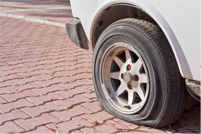
How to Check Your Tire Pressure
 To keep your car driving safely and efficiently, it’s important to inflate your tires to the correct pressure, which is measured in pounds per square inch (PSI). Underinflated tires will wear and overinflated tires are at risk of a blowout. You can find the appropriate PSI for your tires listed in your owner’s manual and on the sticker on the driver’s side door. It may also be visible on the side of your tires. Smaller cars will typically have a tire pressure between 30 and 40 PSI, while larger cars will typically be around 45 PSI.
To keep your car driving safely and efficiently, it’s important to inflate your tires to the correct pressure, which is measured in pounds per square inch (PSI). Underinflated tires will wear and overinflated tires are at risk of a blowout. You can find the appropriate PSI for your tires listed in your owner’s manual and on the sticker on the driver’s side door. It may also be visible on the side of your tires. Smaller cars will typically have a tire pressure between 30 and 40 PSI, while larger cars will typically be around 45 PSI.
Check your tire pressure using an air pressure gauge, which you can buy for a few dollars at any store that sells auto supplies. You can use a standard gauge that measures PSI by the notches on its metered stick or one with a digital reading. It’s best to check tire pressure at a gas station that also has an air station so you can inflate any tires that are on low on air.
Start by removing the caps on all four tire valve stems, which are the air nozzles on the sides of the tires. Use your gauge to check the pressure by placing it evenly onto the valve stem. Your gauge will get a reading of air flow either by blowing out the metered stick or giving a digital reading. The tires with low pressure will need to be inflated.
Pay for air at the stations and then fit the hose nozzle onto the valve stem. It may take some force to press the nozzle firmly in place, but you’ll know when it’s correct when air stops leaking out. To avoid overinflating, remove the hose every few seconds and check the pressure again with your gauge. This may take several repetitions until the pressure reaches the recommended level. Once all tires are inflated, replace the caps and you’re done.
Fully protect your car with comprehensive coverage. Call Pan American Insurance at (915) 562-0009 for more information on El Paso auto insurance.
Categories: Blog
Tags: auto insurance, el paso, insurance, safety, texas, tire pressure
